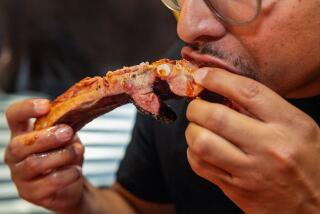Churning Over the Butterfat Crisis
- Share via
At an historic moment last week, Jerry Kozak looked up from his desk in the executive suite and stared across the Potomac at the Capitol dome. He spoke in measured yet optimistic tones. Listening to him, I almost was persuaded that this was not a somber turning point but a natural progression of events, sad as they may be.
“We expect 1999 to be a much more normal year,” he insisted. “The signs are already there.” Perhaps. But what else would you expect from the head of the American Butter Institute? One slip from Kozak and the Butterfat Crisis of 1998 could come to be known generations hence as the Butterfat Riots of 1999.
Yes, President Clinton faces the real possibility of impeachment.
Yes, Wall Street teeters on a vertigo-inducing ledge.
Yes, the American family is falling apart.
Yes, our computers will shut down all power plants, crash all jetliners, open all spillways, and launch all missiles in a mere 12 months and 18 days.
But we can handle that. The immediate problem is that a lump of butterfat now goes for about the same price as a small ruby, casting a pall over all who bake, sell or devour holiday cookies, cakes, pies and other such seasonal delights.
You don’t know the Butterfat Crisis?
Neither did I.
Like many other careless people, I don’t keep track of the basics. I can instantly tell you the capital of North Dakota and the lineup of the 1955 Brooklyn Dodgers, but the price of butter? I like to believe my financial people would tend to such details, if I had financial people.
In any event, the Butterfat Crisis is grave, and like all grave matters it comes from El Nino. The source of every miserable thing from rattlesnake invasions to low SAT scores, El Nino stressed our cows here in California, the nation’s largest dairy state, despite Wisconsin’s cheeses-complex.
A few months after its torrents of mud wrought havoc with California’s cows, El Nino flame-broiled all the cows in Texas.
You will forgive Louise Pichett if her sympathy for the bovine victims is limited.
“Oh, the poor cows,” she said when I told her of their plight.
But who can blame her for being a tad bitter?
Manager of the Viktor Benes Continental Bakery at the Gelson’s supermarket in Westlake Village, Pichett is on the front lines of the Butterfat Crisis. Every time she puts together a Bavarian cream pie, it smacks her in the face. And now, with butter-rich Christmas cookies to make, and costs of dairy ingredients more than doubling last year’s, Louise speaks with gritty determination: “We’ll just have to suffer through it, that’s all,” she said.
Other local bakers sounded the same grim note.
“There’s not much a small business can do,” shrugged Oscar Esmaila, owner of Ventura’s Royal Bakery. “What are you going to do from day to day when the price of butter goes up? ‘Here’s your cookie, but, oh, sorry, I’ve got to charge you another dollar’?”
Bakery prices have gone up modestly here and there but you don’t hear real bakers talk about switching to I Can’t Believe It’s Not Butter.
“Substitutes are not acceptable,” said La Starr Heiliger, owner of a Ventura specialty bakery that has been known to sculpt cake-dough jungle fantasies and champagne magnums.
Heiliger said her icing is made from a Danish formula requiring butter with the highest possible butterfat content. To dilute it would be to diminish it.
“I’m crossing my fingers,” she said. “I’m hoping this will be short-lived.”
*
Of course, La Nina is kinder than her evil brother to the cows that give the milk that holds the butterfat that lends the flavor to the cookies and cakes and pies we’ll soon pork out on. High as they are, butter prices have at least started falling, although nobody knows if they’ll fall very much.
But, in fairness, we can’t blame our bakers’ troubles just on stressed cows.
As the holidays come breathing down our fleshy necks, we can also blame ourselves. For even as butterfat supplies plummeted, we kept demanding more of the stuff.
At the American Butter Institute, Kozak called it “simple economics,” as if any economics were simple.
“Consumers have been migrating back to what I call the full-fat products,” he said.
The figures are well, full.
“With the bagel boom, the cream-cheese market has doubled since 1984,” said Kozak, warming to his topic. “Ice cream consumption has risen 10% from 1990 to 1996. Butter consumption has risen 15% since 1991. Cheese consumption will be more than 28 pounds per capita this year. . . .”
Americans, it seems, are turning their ever-widening backs on diet-this and lite-that. Full-fat is where we’re headed, with icing on top, so if you have to pay a bit more for a cupcake or a muffin or a Christmas cookie, my advice is to just eat it.
More to Read
Get the L.A. Times Politics newsletter
Deeply reported insights into legislation, politics and policy from Sacramento, Washington and beyond. In your inbox twice per week.
You may occasionally receive promotional content from the Los Angeles Times.











